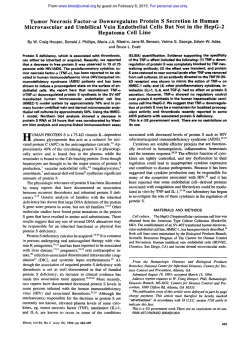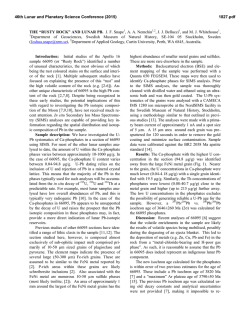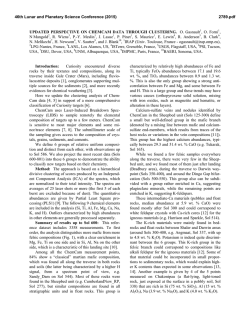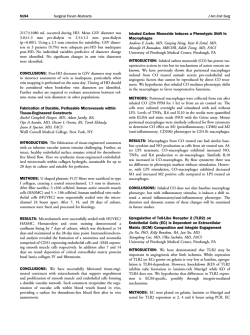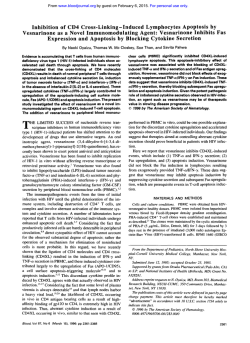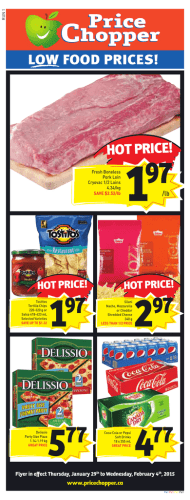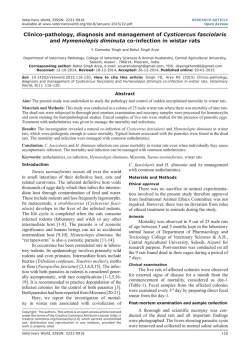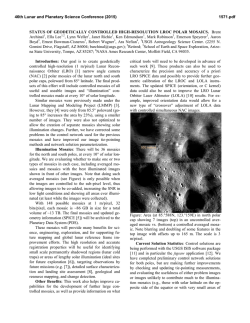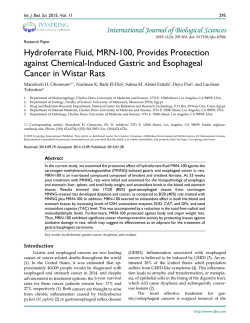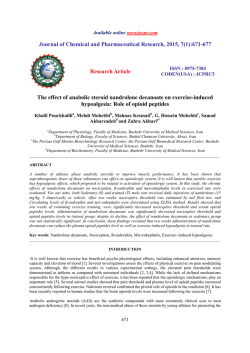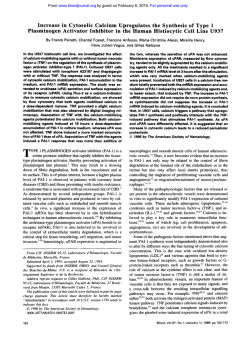
Inhibiting Interleukin-l and Tumor Necrosis Factor-a Does
From www.bloodjournal.org by guest on February 6, 2015. For personal use only. Inhibiting Interleukin-l and Tumor Necrosis Factor-a Does Not Reduce Induction of Plasminogen Activator Inhibitor Type-l by Endotoxin in Rats In Vivo By J.J. Emeis, R. Hoekzema, and A.F. d e Vos In experimental animals and humans, intravenous (IV) injection of endotoxin induces large increases in circulating plasminogen activator inhibitor type-l (PAI-l), a major inhibitor of blood fibrinolysis. A similar increase is seen after the injection of interleukin-l (IL-l)or oftumor necrosisfactor-a (TNFa),suggesting that these cytokines mediate the induction, by endotoxin, of PAI-1.To test this hypothesiswe pretreated rats, before IV endotoxin, with compounds that inhibit the formation of cytokines (pentoxifylline; dexamethasone), or with compounds that inhibit the action of these cytokines (anti-TNF antiserum for TNF-a; IL-l receptor antagonist for IL-l). Noneof these pretreatments affected the induction of PAL1 synthesis by endotoxin. However, pretreatment did reduce the endotoxin-induced increase in plasma tPA antigen concentration. Thus, the data suggest that, in rats in vivo, TNF-a and IL-l are not significantly involved in the induction of PAI-1 by endotoxin. 0 1995 by The American Society of Hematology. P nant human IL-lP (lo8 U/mg; a gift from Dr S. Gillis, Immunex, Seattle, WA) was diluted to 2 pg/mL. Recombinant mouse TNF-a, rabbit-antimouse TNF-a antiserum, and an enzyme-linked immunosorbent assay (ELISA) kit for mouse TNF-a were obtained from Genzyme (Boston, MA). Recombinant human IL-l receptor antagonist (IL-lra; a gift from Dr D.E. Tracey, The Upjohn CO,Kalamazoo, MI) was diluted to 1 mg/mL. Pentoxifylline (Trental) was from Hoechst AG (Wiesbaden, Germany), and was used as supplied (20 mg/mL). Dexamethasone (Sigma) was first dissolved in ethanol ( I O mg/mL), and then diluted to 1 mg/mL in saline. Recombinant human tissue-type plasminogen activator (PA; Activase) was from Genentech(San Francisco, CA). Recombinant rat JMI-229 tPAZ6was a gift from Dr S.D. Prior (Porton Developments Ltd. Salisbury, UK). Rabbit-antirat tPA IgG and rat Lz tPA have been described prev i o u ~ l y Rabbit-antirat .~~ PAI-l IgG was obtained from American Diagnostica (Greenwich, CT). Biotine, avidin-peroxidase, and tetramethylbenzidine were from Pierce (Rockford, IL). Animal experimentation. Male Wistar rats (200 to 250 g body weight) were obtained from the Broekman Institute (Someren, The Netherlands). All experiments were performed under Nembutal anaesthesia (60 mgkg, intraperitoneally). Injections were administered into the vein of the penis. Blood was obtained by aortic puncture into precooled syringes, and anticoagulated with 0.13 m o a trisodium citrate (1 v01to 9 v01of blood). Platelet-poor plasma was immediately prepared at 4°Cby centrifugation for 10 minutes at 2,00Og, and stored at -20°C. Serum was prepared for 30 minutes at 37°C and 30 minutes at 4”C, followed by centrifugation for 10 minutes at 2,0008. Animal experiments had been approved by the Animal Experiments Committee of The Netherlands Organization for Applied Scientific Research TNO, and were in accordance with the guidelines on animal experimentation presented to the International Committee of Thrombosis and Haemostasis.” Experimental design. Rats were injected with a compound under study, followed-after an interval of 30 to 60 minutes, as detailed LASMINOGEN ACTIVATOR inhibitor type-1 (PAI-1) is one of the plasma factors that determine the plasminogen activating potential of blood. Thus, increased blood levels of this inhibitor are likely to reduce blood fibrinolysis and thrombolysis, making PAI-1 a potential risk factor for cardiovascular disease and thromb~embolism.”~ Many types of insult will induce increased levels of plasma PAI-1 activity, examples of which are sepsis, surgery, and trauma.”6 Gram-negative endotoxemia, both experimentally7.’ andclinical1y?-l6 strongly increases the plasma level of PAI-1 in humans. In previous studies, we1’-’’ and other^^^'^-'^ have shown that the injection of low doses of endotoxin into experimental animals will induce large and rapid increases of circulating PAI-1, due to de novo synthesis of PAI-l.24 As a corollary to these studies we have shown that the endotoxin-induced cytokines interleukin-la (IL-1a),I7 IL-1P,l9 and tumor necrosis factor-a (TNF-cY)~~ will also increase plasma PA1 activity in rats. In combination, these observations suggested to us that the endotoxin-induced increase in PAI-1 activity might be mediated by endotoxin-induced cytokines, especially IL- 1 and TNF-a. To test this hypothesis we pretreated rats either with compounds that prevent the synthesis and/or secretion of cytokines (dexamethasone, pentoxifylline) or with compounds that inhibit the effects of cytokines ( L 1 receptor antagonist for IL-1; anti-TNF antiserum for TNF-a), and measured the subsequent endotoxin-induced increase in PAI. We also measured tissue-type plasminogen activator (tPA) antigen levels in these rats, because tPA is known to be increased as well after endotoxin injection. The increase in PA1 activity was not affected byany of these treatments, whereas the increase in tPA antigen was. We propose that, contrary to our hypothesis, the endotoxin-induced cytokines IL-1 and TNF-a are not significantly involved in the induction of PAI-1 by endotoxin. MATERIALS AND METHODS Materials. Endotoxin (lipopolysaccharide [LPS], from Escherichia coli serotype 0128:B12; Sigma, St Louis, MO) was dissolved in sterile saline to a concentration of 10 pg/mL. All other compounds were dissolved in sterile saline containing 1% (wdvol) sterile, pyrogen-free human serum albumin (Central Laboratory of the Red Cross Blood Transfusion Service, Amsterdam, The Netherlands). Recombinant human TNF-a (2.5 X lo7 U/mg protein; a gift from Dr W. Fiers, Biogent, Gent, Belgium) was diluted to 10 pg/mL. RecombiBlood, Vol 85, No 1 (January l ) , 1995: pp 115-120 From Gaubius Laboratory TNO-PG, Leiden; and Netherlands Ophthalmic Research Institute, Amsterdam, The Netherlands. Submitted January 4, 1994; accepted September l , 1994. Presented in part at the XIthInternational Congress on Fibrinolysis (Copenhagen, Denmark, 1992). Address reprint requests to J.J. Emeis, PhD, Gaubius Laboratory TNO-PG, PO Box 430, 2300 AK Leiden, The Netherlands. The publication costs of this article were defrayed in part by page charge payment. This article must therefore be hereby marked “advertisement” in accordance with 18 U.S.C. section 1734 solely to indicate this fact. 0 1995 by The American Society of Hematology. 0006-4971/95/8501-001I $3.Oo/O 115 From www.bloodjournal.org by guest on February 6, 2015. For personal use only. EMEIS, HOEKZEMA, A N D DE VOS 116 Table 1. Effect of Pretreatment With Pentoxifylline or Dexamethasone on the Induction of TNF-a by Endotoxin TNF-a (pg/mL) Pretreatment Saline Pentoxifylline Dexamethasone LPS No controls Individual Data Geometric Mean 45,640 28,958 19,281 11,486 770 1,430 992 693 489 339 1,094 307 248 278 <50 < 50 Rats (four per group) were pretreated with pentoxifylline 20,474 (50 mgi kg IV, 1 hour before LPS), or with dexamethasone(2 mg/kg intraperitoneally, 2 hours before LPS), and subsequently injected with LPS (10 pg/kg). Serumfor thedetermination of TNF-u concentrations was obtained 1 hour after LPS injection. For the determination of TNF-a, see Materials and Methods. nificantly reduced serumTNF-a levels(measured I hour after LPS) from a mean value of 20,500 pg/mL in salinepretreated rats to 770 pg/mL (4% of controls) in pentoxifylline-pretreated rats, and to 339 pg/mL (2% of controls) in 1). At 3hoursafter dexamethasone-pretreatedrats(Table LPS,mean (n = 3) serum TNF-a valueswere 132 pg/mL in saline-pretreatedrats and133pg/mL in pentoxifyllinepretreatedrats,whereas no TNF-a wasdetected in dexamethasone-pretreated animals. Closely similar values were found when TNF-a levels were determined by ELISA, using anELISAkit for mouse TNF-a which also measures rat TNF-a (data not shown). Effect oj' LPS on plasma PAI activity. LPS ( 10 ,ug/kg) induced, as we described p r e ~ i o u s l y , ' ~a ~ large ~ " increase in plasma PA1 activity. In the present study, the plasma PA1 activity averaged, in all saline-pretreated animals combined, 12 1 U/mL at 3 hours after LPS injection, representing a 25fold increase over the baseline level of 4 to 6 U/mL. The identification of the increasedinhibitoryactivityas PAI-I activity has been described,'"24and couldin the present study be confirmed by quenching the LPS-inducedactivity by rabbit-antirat PAI-l IgG (not shown). Effect ofpentoxihlline and dexamethasone on PAI induction b y LPS. Pretreatmentwithpentoxifylline (20, 50, or 100 mg/kg IV, 1 hour before LPS) had no effectonthe induction of PA1 by LPS. Saline-pretreated animals had PA1 levels of 134 5 33 U/mL (mean +- SD; n = 9); pentoxifylline-pretreatedratshad PA1 levels of I18 2 I8 U/mL for pentoxifyllineat 20 mg/kg(n = 5 ) ; 123 +- 13 U/mLfor pentoxifylline at 50 mg/kg (n = 4); and 1 1 I 2 21 U/mL for pentoxifylline at 100 mg/kg (n = 4). These differences were not significant by one-way ANOVA. Injection of only pentoxifylline didnot affect plasma PA1 activity,as we described previously.3'Acute pretreatment with dexamethasone (2 mg/kg intraperitoneally 2 hours before LPS) had no effect on the induction of PA1 by LPS (Table 2), nor did subchronic pretreatment with dexamethasone ( 2 mg/kg intraperitoneally, once daily for 4 days) (Table 2 ) . Corticosterone had no effect either (Table2). Dexamethasone alone(without LPS) increased PA1 activity about twofold.24 below-by the intravenous (IV) injection of LPS( I O pgikg), recombinant human TNF-a (10 pgkg), or recombinant human IL-lp (1 pgikg). Bloodfortheassayof PAI-lactivity was obtained 3 hours'7.'*later. To assess the effect of pretreatment on the induction of TNF-a by LPS, rats were bled 1 hour after LPS. TNF-a assay. TNF-a concentrations were determined in serum by a cytotoxicity assay, usinga subclone of the WEHI 164/13 mouse fibrosarcoma cell line as the indicator cell, essentially as described by EspevikandNissen-Meyer."Theassaywascalibratedusing recombinant mouse TNF-a, and had a lower limit of sensitivity of l pg/mL. Rat serum samples were assayed at dilutions of l:lO, SO, 250,and1,250. In theserumsamplesTNF-awasspecificallydetected at levels 250 pg/mL. PA1 assay. PlasmaPA1concentrationsweredetermined in appropriately diluted plasma by titration with human recombinant tPA (Activase), followed by determination of the residual tPA activity, as described by Verheijen et al."' Results will be expressed as units (U) per milliliter, 1 U/mL being equivalent to 1 ngoftPA inhibited per mL of plasma. tPA antigen assay. RattPAantigenwasdetermined by an ELISA, as follows. Microtiter plates were coated with rabbit-antirat tPA IgGZ7(4 pg/mL in carbonate buffer, pH = 9.0) overnightat 4°C andwashed.Samples(dilutedinphosphate-bufferedsaline[PBS] containing 5 mg/mL casein) wereincubatedovernightat 4°C and washed. Bound tPA was subsequently quantitated using biotinylated Table 2. Effect of Dexamethasone and Corticosteroneon the rabbit-antirattPA IgG, followedby avidin-peroxidase and tetramethInduction of Plasma PA1 Activity by Endotoxin ylbenzidine. Rat tPA purified from Lz cells (0.5 to 4.0 ng/mL) was used as standard. The rat Lz tPA had been calibrated against recombiPA1 Activity (U/mL) No. of Rats nant rat JMI-229 tPA.2bResults will be expressed as nanograms of 8 111 t- 28 Ethanol controls rat tPA per milliliter. 102 2 24 8 Dexamethasone* Statistics. Statisticalsignificance of differences betweengroups 133 i 11 8 Ethanol controls will be analysed by Student's t-test, or by one-wayANOVA fol97 t 24 8 Dexamethasonet lowed by Bonferroni's modified t-test,as indicated. Differences will 105 -C 11 5 Ethanol controls be considered significant if P (two-sided) < .OS. 112 t- 16 5 Corticosterone* RESULTS Effect of pentoxihlline and dexamethasone on TNF-a induction. A pilot experiment (not shown) demonstrated that peak TNF-a levels were found 1 hour after the injection of in LPS ata dose of 10 pgkg. No TNF-a was detectable saline-injected controls. Pretreatment of rats with pentoxifylline (50 m g k g IV 1 hour before LPS), or with dexamethasone (2 m g k g intraperitoneally2hours before LPS), sig- All data shown are mean 2 SD. Rats were pretreated with corticosteroids as indicated, followed by LPS (10 pg/kg IV). Plasma for PA1 determinations was obtained 3 hours after LPS.For further details, see Materials and Methods. No significant differences betweentreatment and control groups were present. * Dexamethasone 2 mg/kg intraperitoneally, daily for 4 days before LPS (10 pg/kg IV). t Dexamethasone 2 mg/kg intraperitoneally, 2 hours before LPS. + Corticosterone 50 mg/kg intraperitoneally, 2 hours before LPS. From www.bloodjournal.org by guest on February 6, 2015. For personal use only. 117 LPS, PAI-1,ANDCYTOKINES Table 3. Effect of Anti-TNF Antiserum, Interleukin-l-Receptor Antagonist, or Both, on PA1 Induction 1. Saline, then LPS 2. Control rabbit serum, then LPS 3a. Anti-TNF antiserum (0.1 mL), then LPS 3b. Anti-TNF antiserum (0.3 mL), then LPS 4a. IL-lra (1 mg/kg), then LPS 4b. IL-lra (4 mg/kg), then LPS 5. Anti-TNF (0.1 mL) plus IL-lra (1 mglkg), then LPS 6. Control rabbit serum, then TNF 7a. Anti-TNF antiserum (0.1 mL), then TNF 7b. Anti-TNF antiserum (0.3 mL), then TNF 8. Saline, then IL-l 9a. IL-lra (1 mg/kg), then IL-l 9b. IL-lra (4 mg/kg), then IL-l PA1 Activity WmL) No. of Rats 131 2 45 10 1452 5 4 136 2 57 4 113; 141 154 2 32 133; 148 2 4 2 156 2 8 4 52 -c 7 4 30 2 4 4 5; 8 16 -C 2 10 2 1 5; 6 All data shown are mean 2 SD, or individualvalues of two animals. No significant differences were present between groups 1-5 by oneway ANOVA. Group 6 was significantly different from group 7a. and group 8 from group 9a. by Student‘s t-test. Rats were pretreated with anti-TNF antiserum (0.1 or 0.3 murat), with control rabbitserum (0.1 murat), with IL-Ira (1 or 4 mg/kg), or with saline, followed by either LPS (10 pg/kg), recombinant human TNF-a (10 pg/kg), or recombinant human IL-1/3 (1 pgikg).Rats were killed 3 hours after LPS, TNF or IL1. For further details, see Materials and Methods. Effect of anti-TNF antiserum, IL-I receptor antagonist (IL-Ira), or both, on PAI induction by LPS. Pretreatment of rats with an antimouse-TNF antiserum (0.1 mL/rat) had no significant effect on the induction of PA1 by LPS, compared to pretreatment with control rabbit serum (Table 3). Higher doses of the antiserum (0.15 or 0.3 mUrat, n = 2 per dose) had noeffect either (Table 3). The anti-TNF antiserum did reduce, though, the induction ofPA1 activity by recombinant human TNF-a, inhibiting partially at a dose of 0.1 mL/rat and fully at a dose of 0.3 mL/rat (Table 3). At a dose of 1 mgkg, recombinant human IL-lra significantly inhibited the induction of PAI-l activity by recombinant human IL-Ip (1 & k g ) , whereas at a dose of 4 mgkg the receptor antagonist fully inhibited the induction by IL-1p (Table 3). In contrast, IL-lra did not affect the induction of PA1by LPS at all (Table 3). Combined pretreatment with anti-TNF and IL-lra had no effect on the induction of PA1 by LPS either (Table 3). Additive effects of TNF-a and IL-IP. To see whether residual circulating levels of one cytokine would potentiate the other, rats (two per group) were injected with TNF-a (10 & k g ) with or without simultaneous injection of a small dose of IL-lp (0.1 pgkg), or with only IL-1p (0.1 Fgkg). No potentiating effect on PA1 induction was observed: TNFa alone gave PA1 activities of 18 and 20 U/mL; IL-1p alone 8 and 11 U/mL; TNF-a plus IL-lp 19 and 20 U/&. Sirni- larly, no potentiation of IL-lp (1 & k g ) by a small dose of TNF-a (1 pgkg) was seen: IL-1p alone gave PA1 activities of 25 and 25 U/mL; TNF-a alone 12 and 13 U/mL; IL-lp plus TNF-a 30 and 38 U/mL. IL-lp (1 & k g ) plus TNF-a (10 & k g ) gave 35 and 42 U/mL. These data suggest that the combined effect of IL-1p and TNF-a is additive rather than synergistic. This makes it unlikely that residual amounts of TNF-a activity [remaining after anti-TNF treatment) would potentiate IL-lp, or that residual L - l p activity (after IL-lra treatment) would potentiate TNF-a. The effect of TNF-a on PAI-1 was linearly related to the injected dose of TNF-a over the dose-range 0.5 to 60 , & k g (n = 9; r = .895; P < .01). Changes in tPA antigen concentrations. LPS induced a time-dependent increase in tPA antigen (Fig l), preceding the induction of PA1 which commences only after 1 hour.” Increases in tPA antigen of a magnitude similar to that induced by LPS were found at 3 hours after the injection of IL-1p and TNF-a (Table 4). The tPA increase after LPS was partly inhibited by pentoxifylline, dexamethasone, antiTNF antiserum, and IL-l-ra (Table 4). Similarly, anti-TNF antiserum and IL-l-ra partly inhibited the tPA increase induced by, respectively, TNF-a and IL-lp (Table 4). Inhibition was not complete, presumably because the high PA1 levels in the circulation caused the formation of more tPAPA1 complexes, which are cleared from the circulation more slowly than uncomplexed tPA.32 DISCUSSION This study was designed to test the hypothesis that the induction of PAI-l by endotoxin is mediated by the cytokines TNF-a and/or IL-1. This hypothesis originated from two sets of observations. Firstly, the observation that endotoxin, a potent inducer of PAI-1, is also a potent inducer in vivo of IL-1 and TNF-a. Secondly, the observation that both cytokines will increase PAL1 in vivo. IL-la and p have been shown to induce PAL1 in rats,”*19whereas TNF-a g.60 0.00 t A I ’ 0 / 30 60 /l I I 90 120 150 160 time (min) Fig1. Time course of tPA antigen concentrations in rat plasma after the IV injection of LPS (10 pglkgl. Data shown are mean 2 SD of four animals, or single values of two animals (at 30 and 90 minutes). tPAantigenwasdeterminedasdescribedinMaterialsand Methods. From www.bloodjournal.org by guest on February 6, 2015. For personal use only. 118 EMEIS, HOEKZEMA, AND DE VOS Table 4. Effect of Pretreatment on Endotoxin-Induced tPA Antigen Levels tPA Antigen (ngimL1 1. 2. 3. 4. 5. 6. 7. 8. 9. 10. 11. Saline-treated control rats Saline, then LPS Normal rabbit serum, then LPS Pentoxifylline, then LPS Dexamethasone, then LPS Anti-TNF antiserum, then LPS IL-lra, then LPS Control rabbit serum, then TNF Anti-TNF antiserum, then TNF Saline, then IL-l IL-lra, then IL-l 2.4 8.1 8.4 6.2 6.3 6.3 5.8 5.7 3.2 6.2 3.6 i- 0.2 i- 2.5 i- 3.0 t 1.5 ? 1.2 ? 1.3 2 1.8 -+ 0.3 i- 0.1 i- 1.0 f 0.3 No. of Rats 4 10 4 4 4 4 4 4 4 3 3 All data shown are mean 2 SD. Groups 2-7 were not significantly different by one-way ANOVA. When groups 2 and 3 and groups 4-7 v pretreated) were combined, the two new groups (non-pretreated were significantly different by Student‘s t-test(P< .01). Group 8 was significantly different from group 9, and group 10 from group 11, b y Student‘s t-test ( P < .05).Rats were pretreated with saline, control rabbit serum (0.1 murat), pentoxifylline (50 mg/kg IV), dexamethasone (2 mg/kg intraperitoneally), anti-TNF antiserum (0.1 murat), or IL-Ira (1 mg/kg), followed by either LPS (10 pg/kg), recombinant human TNF-(U (10 pg/kg), or recombinant human IL-ID (1 pg/kg). Rats were killed 3 hours after LPS,TNF, or IL-l. For further details, see Materials and Methods. has been shown to induce PAI-I in mice,’? rat^,'"^^^'^ and humans.35-3K However, the present study provided no support for our hypothesis: all four procedures meant to interfere with the production and/or action of cytokines (pretreatment with pentoxifylline, dexamethasone, anti-TNF antiserum, or IL-I receptor antagonist) all failed to reduce the induction of PAL1 by endotoxin. Pentoxifylline inhibitstheinduction,byendotoxin, of TNF-a synthesis by inhibiting the transcription of TNF-a mRNA.” It is effective in all species tested, including humans:’ ~ h i m p a n z e e , ~ ” ~ ’ and rat.43 In this study, it inhibited the induction of TNF-a by 96%(Table l), but failed to affect the induction of PAI-I by endotoxin. Dexamethasone, which inhibits thetranslation of TNF-a mRNA? also inhibited the induction of TNF-a (by 98%, Table l), in agreement with a study in rats which used a similar dosage regimen?’ But, like pentoxifylline, dexamethasone had no effect on PA1 induction (Table 2 ) . In addition, an antimurine-TNF antiserum that also inhibits rat TNF-a had no effect onPA1 induction, though it fully inhibited the induction of PA1 by (human) TNF-a (Table3). All in all,thesedatashowedthat blocking the synthesis (pentoxifylline, dexamethasone), or the effect (anti-TNFantiserum) of TNF-a did not affect the induction of increased PAI- 1 synthesis by endotoxin. Similar to TNF-a, IL-lP is induced in rats by albeit moreslowly,peak levels being obtained only at 5 hours after endotoxin ie, after the peak level of PAL1 has been reached (at 3 to 4 hours”). Dexamethasone also inhibits, as for TNF-a, the induction of IL-1 activity4’ and of IL-l mRNA,4* via effects on translation and secret i ~ n . ~Pentoxifylline ’ is not known to reduce the induction of IL-I .”) To block the effects of IL-I, we used an IL- 1 receptor antagonists’.52 that effectively inhibits ILI -induced effects in variety a of species,s3 including However, no effect on PAI- 1 induction like dexamethasone, IL- 1 ra had by endotoxin in this study, though it inhibited the induction of PA1 by human IL-lP (Table 3). Endotoxin not onlyinducesincreasedplasmalevels of PAI-I, but also oftPA,induction of tPApreceding that of PAI-1, has as been observed both in and in chimpanzees.“ Increased tPA antigen levels have also been described in humans after treatment with TNF-cx.”-’~ In the present study similar increases were noted after treatment of rats with endotoxin (Fig l ) , TNF-a, and IL-I@ (Table 4), an observation not made in ratsbefore. The increaseintPA antigen after the injection of TNF-a was reduced by antiTNF antiserum, and the increase after IL-I@by IL- Ira (Table 4). The increase in tPAantigenafterendotoxin injection was reduced, though to a lesser extent, by pretreatment with pentoxifylline, dexamethasone, anti-TNF antiserum, and ILIra. This suggeststhat pretreatment with anti-TNF antiserum and IL-Ira was not only effective against injected (human) TNF-a or IL-l@, but also against endogenous TNF-a and IL-I . That tPA was not reduced to normal control levels is presumably due to the fact, mentioned above,that the induction of PAI-1 still occurred in all animals, resulting in increasedcirculatinglevels of tPA-PA1 complexes thatare detected by our tPA ELISAassay. Also, it is likelythat tPA release is induced” after endotoxin injection by other endotoxin-induced compounds suchasplatelet-activating factor, catecholamines, vasopressin, etc. Because synergistic effects between TNF-a and IL-1 have been reported (eg, ref 56), and because in our experiments low residuallevels of cytokines activity are likely to be present during treatment with antiserum or withreceptor antagonist, we investigatedwhethersynergistic effects on PA1 synthesis couldbe detected. Asdescribedabove, no such synergy between TNF-a and IL-10 was found, using various combinations of the two cytokines, but rather additive effects. Moreover, because the PA1 response to TNF-a was linear over the TNF concentration range 0.5 to 60 ,ug/ kg, we considerit unlikely that residual amounts of TNF (or IL-I) would significantly have affected the PA1 concentrations. In a previous publicationz4 we have shown that a variety of autacoids that are induced or released by endotoxin in vivo (eg,cyclo-oxygenaseandlipoxygenase products,plateletactivating factor, catecholamines, histamine, cyclic nucleotides, opioids, vasopressin, thrombin) are not involved in the induction of PAI-I by endotoxin. It has also been shown that IL-6 is unable to induce PAL1 in rats in v~vo,’~,’’ as is the case in vitro.25,’XOur present observations suggest that IL-1 andTNF-ado not mediatetheeffect ofendotoxin on PAI-l either. Thus, the mechanism by which endotoxin induces increased synthesis of PAL1 in vivo remains unexplained. This situationisthemoreunfortunatebecauseit was recently suggested2’ that TNF-a mediates, in chimpanzees, the endotoxin-induced increase in tPA that precedes the increase in PAL1 activity, an observation in agreement with our data. It follows that inhibiting TNF-a will, at least From www.bloodjournal.org by guest on February 6, 2015. For personal use only. LPS,PAI-1, AND CMOKINES inrats,inhibittheprofibrinolytic,tPA-mediated, effect of endotoxin without interfering with its antifibrinolytic, PAI1 -mediated effect. In combination, theseeffects might then shift thefibrinolyticbalanceinblood even furthertoan inhibitory state, worsening the procoagulant effects of endotoxin. It would be of interest to study whetherthis situation, as described here for rats, also applies to primates and humans. ACKNOWLEDGMENT The authors are indebted to Dr W. Fiers (Biogent, Gent, Belgium) for a gift of recombinant human TNF-a;to Dr S. Gillis (Immunex, Seattle, WA) for a gift of recombinant human IL-lP; to Dr D.E. Tracey (The Upjohn CO,Kalamazoo, MI) for providing recombinant human IL-l receptor antagonist; and to Dr M. Schanharting (Hoechst AG, Wiesbaden, Germany) for providing pentoxifylline. We thank M. Bekkers and C.M. van den Hoogen for expert technical assistance. REFERENCES 1. Wiman B, Hamsten A: Impaired fibrinolysis and risk of thromboembolism. Prog Cardiovasc Dis 34:179, 1991 2. Prins MH, Hirsh J: A critical review of the relationship between impaired fibrinolysis and myocardial infarction. Am Heart J 122:545, 1991 3. Dawson S, Henney A: The status of PAI-l as a risk factor for arterial and thrombotic disease: a review. Atherosclerosis 95:105, 1992 4. Sprengers ED, Kluft C: Plasminogen activator inhibitors. Blood 69:381, 1987 5. Kruithof EKO: Plasminogen activator inhibitor type 1: Biochemical, biological and clinical aspects. Fibrinolysis 2:59, 1988 (SUPPl 2) 6. Loskutoff DJ: Regulation of PAI-I gene expression. Fibrinolysis 5:197, 1992 7. Suffredini AF, Harpel PC, Pari110 JE: Promotion and subsequent inhibition of plasminogen activation after administration of intravenous endotoxin to normal subjects. N Engl J Med 320:1165, 1989 8. van Deventer SJH, Buller HR, ten Cate J W , Aarden LA, Hack CE, Sturk A: Experimental endotoxemia in humans: Analysis of cytokine release and coagulation, fibrinolytic and complement pathways. Blood 76:2520, 1990 9. Colucci M, Paramo JA, Collen D: Generation in plasma of a fast-acting inhibitor of plasminogen activator in response to endotoxin stimulation. J Clin Invest 75:818, 1985 10. Engebretsen LF, Kierulf P, Brandzaeg P: Extreme plasminogen activator inhibitor and endotoxin values in patients with meningococcal disease. Thromb Res 42:713, 1986 11. Ptiramo JA, Fernhdez Diaz FJ, Rocha E Plasminogen activator inhibitor activity in bacterial infection. Thromb Haemost 59:451, 1988 12. Pralong G, Calandra T, Glauser M-P, Schellekens J, Verhoef J, Bachmann F, Kruithof EKO: Plasminogen activator inhibitor 1: A new prognostic marker in septic shock. Thromb Haemost 61:459, 1989 13. Ptiramo JA, PCrez JL, Serrano M, Rocha E: Types 1 and 2 plasminogen activator inhibitor and tumor necrosis factor alpha in patients with sepsis. Thromb Haemost 64:3, 1990 14. Voss R, Matthias FR, Borkowski G, Reitz D: Activation and inhibition of fibrinolysis in septic patients in an internal intensive care unit. Br J Haematol 75:99, 1990 15. Philipp5 J, Offner F, Declerck PJ, Leroux-Roels G, Vogelaers 119 D, Baele G , Collen D: Fibrinolysis and coagulation in patients with infectious disease and sepsis. Thromb Haemost 65:291, 1991 16. Kruithof EKO, Calandra T, Pralong G, Heumann D, GCrain J, Baumgartner JD, Bachmann F, Glauser MP: Evolution of plasminogen activator inhibitor type 1 in patients with septic shock-correlation with cytokine concentrations. Fibrinolysis 7: 117, 1993 17. Emeis JJ, Kooistra T: Interleukin-l and lipopolysaccharide induce an inhibitor if tissue-type plasminogen activator in vivo and in cultured endothelial cells. J Exp Med 163:1260, 1986 18. Quax PHA, van den Hoogen CM, Verheijen JH, Padri, T, Zeheb R, Gelehrter TD, van Berkel TJC, Kuiper J, Emeis JJ: Endotoxin induction of plasminogen activator and plasminogen activator inhibitor type-l mRNA in rat tissues in vivo. J Biol Chem 265:15560, 1990 19. Emeis JJ, Brouwer A, Barelds M,Horan MA, Durham SK, Kooistra T: On the fibrinolytic system in aged rats, and its reactivity to endotoxin and cytokines. Thromb Haemost 67:697, 1992 20. Padri, T, Quax PHA, van den Hoogen CM, Roholl P, Verheijen JH, Emeis JJ: Tissue-type plasminogen activator and its inhibitor in rat aorta. Effect of endotoxin. Arterioscler Thromb 14:1459, 1994 21. Dosne AM, Dubor F, Chedid L: Plasminogen activator inhibitor induced by lipopolysaccharide injection in the rat. Fibrinolysis 1:45, 1987 22. Siebeck M,Spannagl M, Hoffmann H, Schramm W, Fritz H: Time dependent release of tissue-type plasminogen activator and plasminogen activator inhibitor into the circulation of pigs during shock. Blood Coagul Fibrinolysis 2:459, 1991 23. Levi M, ten Cate H, Bauer KA, van der Poll T, Edgington TS, Buller HR, van Deventer SJH, Hack CE, ten Cate JW, Rosenberg RD. Inhibition of endotoxin-induced activation of coagulation and fibrinolysis by pentoxifylline or by a monoclonal anti-tissue factor antibody in chimpanzees. J Clin Invest 93:114, 1994 24. Emeis JJ, van den Hoogen CM: Pharmacological modulation of the endotoxin-induced increase in plasminogen activator inhibitor activity in rats. Blood Coagul Fibrinolysis 3:375, 1992 25. Van Hinsbergh VWM, Kooistra T, van den Berg EA, Princen HMG, Fiers W, Emeis JJ: Tumor necrosis factor increases the production of plasminogen activator inhibitor in human endothelial cells in vitro and in rats in vivo. Blood 72:1467, 1988 26. Lijnen HR. Webb PD. van Hoef B, de Cock F, Stassen JM, Prior SD, Collen D: Biochemical and biological properties of a recombinant tissue-type plasminogen activator derived from the rat JMI-229 cell line. Thromb Haemost 67:239, 1992 27. Padr6 T, van den Hoogen CM, Emeis JJ: Distribution of tissue-type plasminogen activator (activity and antigen) in rattissues. Blood Coagul Fibrinolysis 1:601, 1990 28. Giles AR: Guidelines for the use of animals in biomedical research. Thromb Haemost 58:1078, 1987 29. Espevik T, Nissen-Meyer J: A highly sensitive cell line, WEHI 1 6 4 clone 13, for measuring cytotoxic factor/tumor necrosis factor from human monocytes. J Immunol Methods 95:99, 1986 30. Verheijen JH, Chang GTG, Kluft C. Evidence for the occurrence of a fast-acting inhibitor for plasminogen activator in human plasma. Thromb Haemost 51:392, 1984 3 1. Tranquille N, Emeis JJ: The effect of pentoxifylline (Trental) and two analogues, BL 194 and HWA448, on the release of plasminogen activators andvon Willebrand factor in rats. J Cardiovasc Pharmacol 18:35, 1991 32. Chandler WL, Levy WC, Veith RC, Stratton JR: A kinetic model of the circulatory regulation of tissue plasminogen activator during exercise, epinephrine infusion, and endurance training. Blood 81:3293, 1993 33. Sawdey MS, Loskutoff DJ: Regulation of murine type-l plasminogen activator inhibitor gene expression in vivo. Tissue specific- From www.bloodjournal.org by guest on February 6, 2015. For personal use only. 120 ity and induction by lipopolysaccharide, tumor necrosis factor-a and transforming growth factor. J Clin Invest 88: 1346, 1991 34. Dosne AM, Dubor F, Lutcher F, Parant M, Chedid L: Tumor necrosis factor (TNF) stimulates plasminogen activator inhibitor (PAI) production by endothelial cells in vitro and decreases blood fibrinolytic activity in the rat. Thromb Res Suppl VI1I:I 15, 1988 35. Van Hinsbergh VWM, Bauer KA, Kooistra T, Kluft C, Dooijewaard G, Sherman ML, Nieuwenhuizen W: Progress in fibrinolysis during tumor necrosis factor infusions in humans. Concomitant increase in tissue-type plasminogen activator, plasminogen activator inhibitor type-l, and fibrin(ogen) degradation products. Blood 76:2284, 1990 36. Silverman P, Goldsmith GH, Spitzer TR, Rehmus EH, Berger NA: Effect of tumor necrosis factor on the humanfibrinolytic system. J Clin Oncol 8:468, 1990 37. Van der Poll T, Levi M, Biiller HR, van Deventer SJH, de Boer JP, Hack CE, ten Cate JW: Fibrinolytic response to tumor necrosis factor in healthy subjects. J Exp Med 168:751, 1991 38. Logan TF, Virji MA, Gooding WE, Bontempo FA, Ernstoff MS, Kirkwood JM: Plasminogen activator and its inhibitor in cancer patients treated with tumor necrosis factor. J Natl Cancer Inst 84: 1802, I992 39. Strieter RM, Remick DG, Ward PA, Spengler RN, Lynch JP, Larrick J, Kunkel SL: Cellular and molecular regulation of tumor necrosis factor-alpha production by pentoxifylline. Biochem Biophys Res Commun 155:1230, 1988 40. Zabel P,Wolter DT, Schonharting M, Schade U F Oxpentifylline in endotoxaemia. Lancet 2:1474, 1989 41. Van Leenen D, van der Poll T, Levi M,ten Cate H, van Deventer SJH, Hack CE, Aarden LA, ten Cate JW: Pentoxifylline attenuates neutrophil activation in experimental endotoxemia in chimpanzees. J Immunol 151:2318, 1993 42. Schade UF: Pentoxifylline increases survival in murine endotoxin shock and decreases formation of tumor necrosis factor. Circ Shock 31:171, 1990 43. Noel P, Nelson S, Bokulic R, Bagby G, Lippton H, Lipscomb G, Summer W: Pentoxifylline inhibits lipopolysaccharide-induced serum tumor necrosis factor and mortality. Life Sci 47:1023, 1990 44. Han J, Thompson P, Beutler B. Dexamethasone and pentoxifylline inhibit endotoxin-induced cachectidtumor necrosis factor synthesis at separate points inthe signaling pathway. J Exp Med 172:391, 1990 45. Waage A: Production and clearance of tumor necrosis factor in rats exposed to endotoxin and dexamethasone. Clin Immunol Immunopathol 445:348, 1987 46. BristowAF,Mosley K, Poole S: Interleukin-lp production in vivo and in vitro in rats and mice measured using specific immunoradiometric assays. J Mol Endocrinol 7: 1, 1991 47. Staruch MJ, WoodDD: Reduction of serum interleukin-l- EMEIS,HOEKZEMA, AND DE VOS like activity after treatment with dexamethasone. J LeukocBiol 37:193, 1985 48. Ulich TR, Guo K, Irwin B, Remick DC, Davatelis GN: Endotoxin-induced cytokine expression in vivo. 11. Regulation of tumor necrosis factor and interleukin-la/P expression and suppression. Am J Pathol 137: 1 173, 1990 49. Kern JA, Lamb RJ, Reed JC, Daniele RP, Nowell PC: Dexamethasone inhibition of interleukin 1 beta production by human monocytes. Posttranscriptional mechanisms. J Clin Invest 81:237, 1988 SO. Weinberg JB, Mason SN, Wortham TS: Inhibition of tumor necrosis factor-a (TNF-a) and interleukin- IP (IL- I@) messenger RNA (mRNA) expression in HL-60 leukemia cells by pentoxifylline and dexamethasone: Dissociation of acivicin-induced TNF-a and IL- IP mRNA expression from acivicin-induced monocytoid differentiation. Blood 79:3337, 1992 51. Carter DB, Deibel MR, Dunn CJ, Tomich C-SC, Ldborde AL, Slightom JL, Berger AE, Bienkowski MJ, Sun FF, McEwan RN, Harris PKW, Yem AW,WaszakGA, Chosay JG, Sieu LC, Hardee MM, Zurcher-Neely HA, Reardon IM, Heinrikson RL, Truesdell SE, Shelly JA, Eessalu TE, Taylor BM, Tracey DE: Purification, cloning, expression and biological characterization of an interleukin-l receptor antagonist protein. Nature 344:633, 1990 52. Hannum CH, Wilcox CJ, Arend WP, Joslin FG, Dripps DJ, Heimdal PL, Armes LG, Sommer A, Eisenberg SP, Thompson RC: 1990. Interleukin-l receptor antagonist activity of a human interleukin-l inhibitor. Nature 343:336, 1990 53. Dinarello CA, Thompson RC: Blocking IL-l: Interleukin I receptor antagonist in vivo and in vitro. ImmunolToday 12:4W, 1991 54. Alexander HR, Doherty GM, Venzon DJ, Merino MJ, Fraker DL, Norton JA: Recombinant interleukm- 1 receptor antagonist (ILIra): Effective therapy against gram-negative sepsis in rats. Surgery I 12:188, 1992 55. Emeis JJ: Mechanisms involved in short-term changes in blood levels of tissue-type plasminogen activator, in Kluft C (ed): Tissue-Type Plasminogen Activator: Physiological and Clinical Aspects, v01 2. Boca Raton, FL, CRC, 1988, p 21 56. Waage A, Espevik T: Interleukin 1 potentiates the lethal effect of tumor necrosis factor alcachectin in mice. J Exp Med 167:1987, 1988 57. Podor TJ, Hirsh J, Gelehrter TD, Zeheb R, Tony D, Guigoz Y, Sierra F, Gauldie J: Type 1 plasminogen activator inhibitor is not an acute phase reactant in rats. Lack of IL-6- and hepatocytedependent synthesis. J Immunol 150:225, 1993 58. De Boer JP, Abbink JJ, Brouwer MC, Meijer C, Roem D, Voorn GP, Lamberts JWJ, van Mourik JA, Hack CE: PAI-I synthesis in the human hepatoma cell line HepG2 is increased by cytokines. Thromb Haemost 65:181, 1991 From www.bloodjournal.org by guest on February 6, 2015. For personal use only. 1995 85: 115-120 Inhibiting interleukin-1 and tumor necrosis factor-alpha does not reduce induction of plasminogen activator inhibitor type-1 by endotoxin in rats in vivo JJ Emeis, R Hoekzema and AF de Vos Updated information and services can be found at: http://www.bloodjournal.org/content/85/1/115.full.html Articles on similar topics can be found in the following Blood collections Information about reproducing this article in parts or in its entirety may be found online at: http://www.bloodjournal.org/site/misc/rights.xhtml#repub_requests Information about ordering reprints may be found online at: http://www.bloodjournal.org/site/misc/rights.xhtml#reprints Information about subscriptions and ASH membership may be found online at: http://www.bloodjournal.org/site/subscriptions/index.xhtml Blood (print ISSN 0006-4971, online ISSN 1528-0020), is published weekly by the American Society of Hematology, 2021 L St, NW, Suite 900, Washington DC 20036. Copyright 2011 by The American Society of Hematology; all rights reserved.
© Copyright 2025
